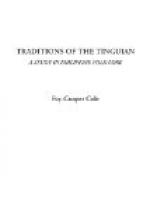As soon as they arrived there the families who made the balaua went to meet them at the gate of the town and made alawig [171] for them. After that they stopped dancing, and they talked to each other, and the two young men who met Aponibolinayen and Aponigawani were with them, because they arrived at the same time. So the old man Pagatipanan said, “Ala, cousin Pagbokasan now we are going to chew betel-nut to see if those two young men who took home Aponigawani are our relatives,” and old man Pagbokasan agreed. So they cut the betel-nut which was covered with gold for them to chew and as soon as they cut the nut they all chewed, and they all spat. The spittle of Lingiwan went to the spittle of Pagatipanan, and the spittle of Aponigawani, went there also. The spittle of Dangdangayan went to the spittle of Pagbokasan and that of Aponibolinayen also, and thus they found out that they were relatives. Pagbokasan was surprised, for he did not know that he had a son, and Ebang took her son, and she carried him as if he was a baby. And Lingiwan was glad, because he had met his sister during the fight and Langa-an carried him as if a baby.
When they had learned that the boys who had carried the girls home were their sons they all went back to town, and their people who had been invited were there. As soon as they sat down Iwaginan commanded someone to play the gansas and he took the two skirts and made everyone dance. His wife Gintoban who was a big woman, who used the big jars like agate beads on her head and about her neck, said to Iwaginan, “Why don’t you, my husband, bid me dance? I have been waiting for a very long time.” Iwaginan said, “Gintoban do not say that or I shall be ashamed before the people. Wait until I am ready for you.” As soon as Aponibolinayen and Lingiwan finished dancing Iwaginan took the skirts from them and he gave one to Gintoban and the other to Ilwisan, and so they danced. And the big jars which she had hung around her neck made a noise and the earth shook when she moved her body. As soon as they finished dancing the people who went to attend Balaua with them said, “Now we going to put the heads around the town and then go for it is nearly one month now and our families are lonesome for us.” So they went to put the heads on the sticks around the town.




